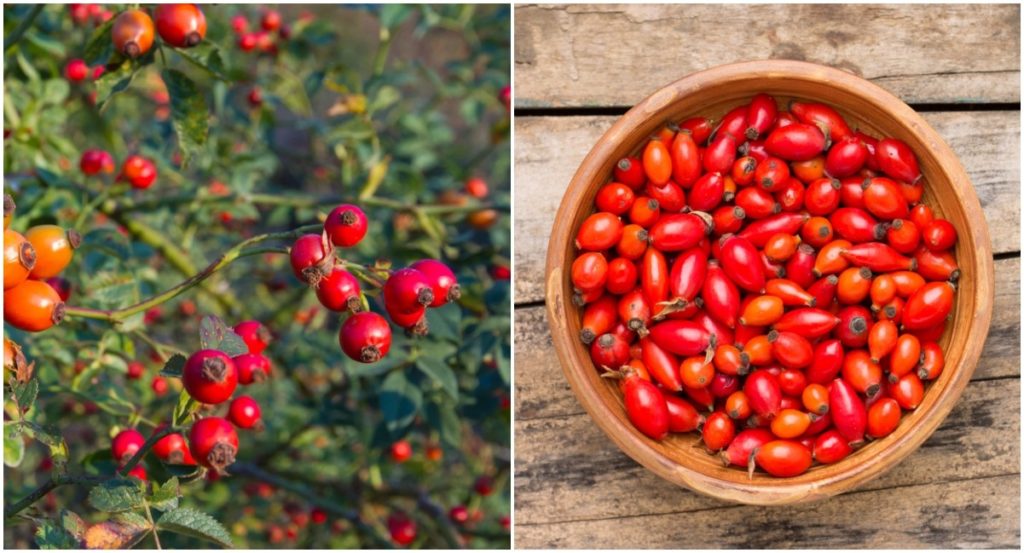
Rosehips are definitely one of the defining flavours of the fall. Yet many people are unaware that many rose bushes develop these useful hips (if they are given the chance to).
Roses are one of the favourite ornamental plants. But what many people do not realise is that they are also part of the same family as apples, and also produce edible fruits.
What are Rosehips?
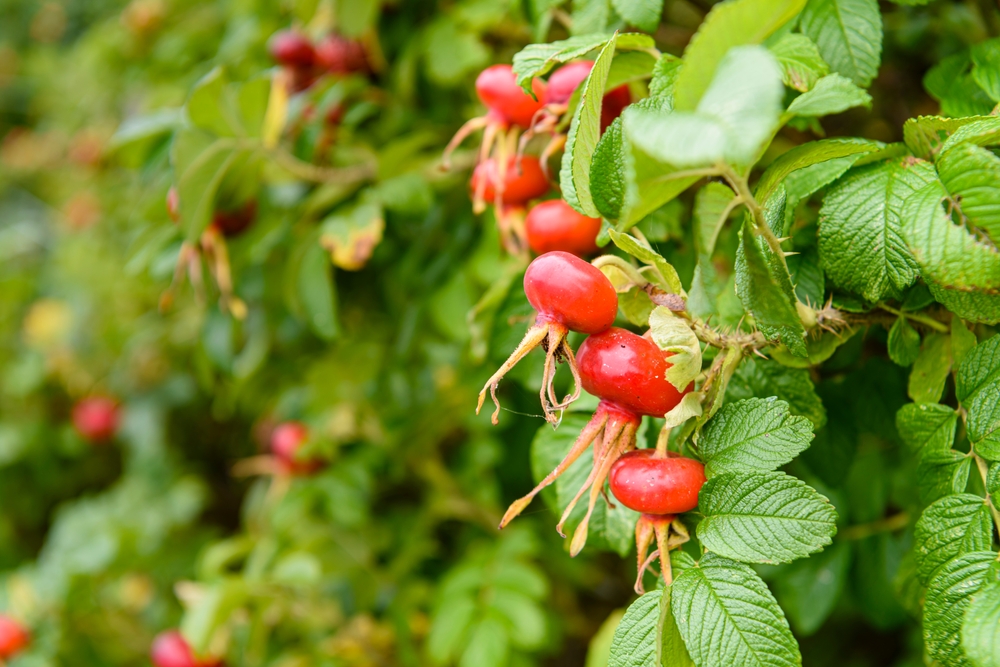
The hips that are produced by roses are the aggregate fruits of the plants. Hips are produced on the plants after the flowers have been pollinated by insects.
While most rose bushes bear hips, many domestic cultivars do not produce hips, because the flowers are so densely petalled that they do not provide access for pollination.
The rose hips of some species, especially the dog rose (Rosa canina) and rugosa rose (Rosa Rugosa) are extremely rich in vitamin C – amongst the plants with the richest source of this vitamin.
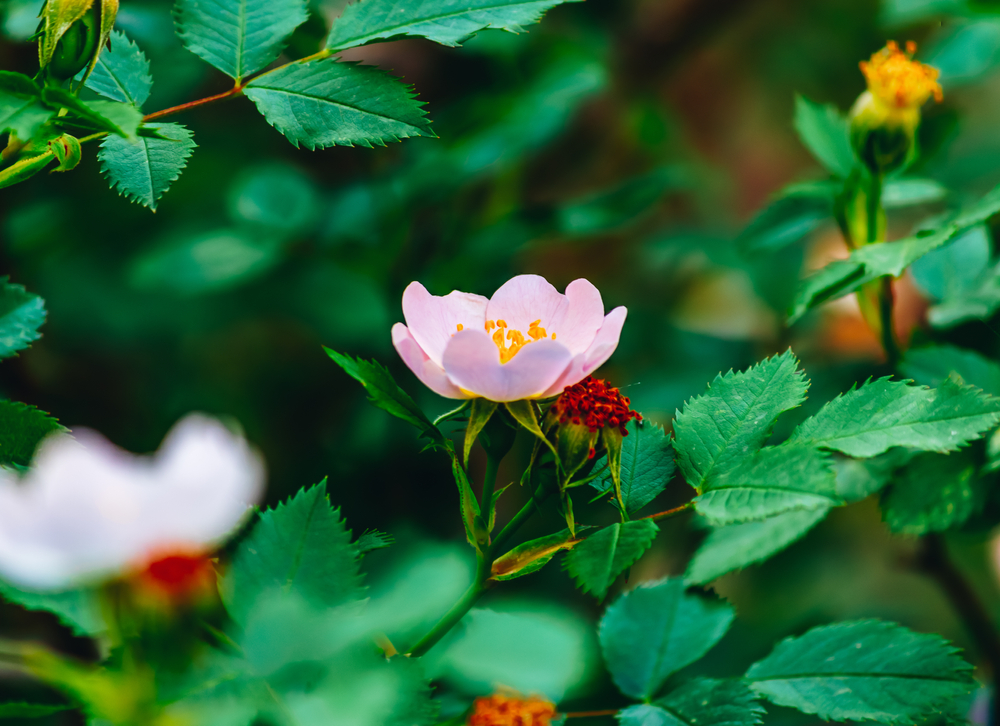
The hips on most roses are red, berry-like structures. These can vary in size. They have a fleshy but firm outer layer, called the hypanthium, and between 5 and 160 seeds (technically single-seeded fruits called achenes) within this outer casing.
The seeds are embedded in a matrix of stiff, fine hairs.
How To Identify Rosehips
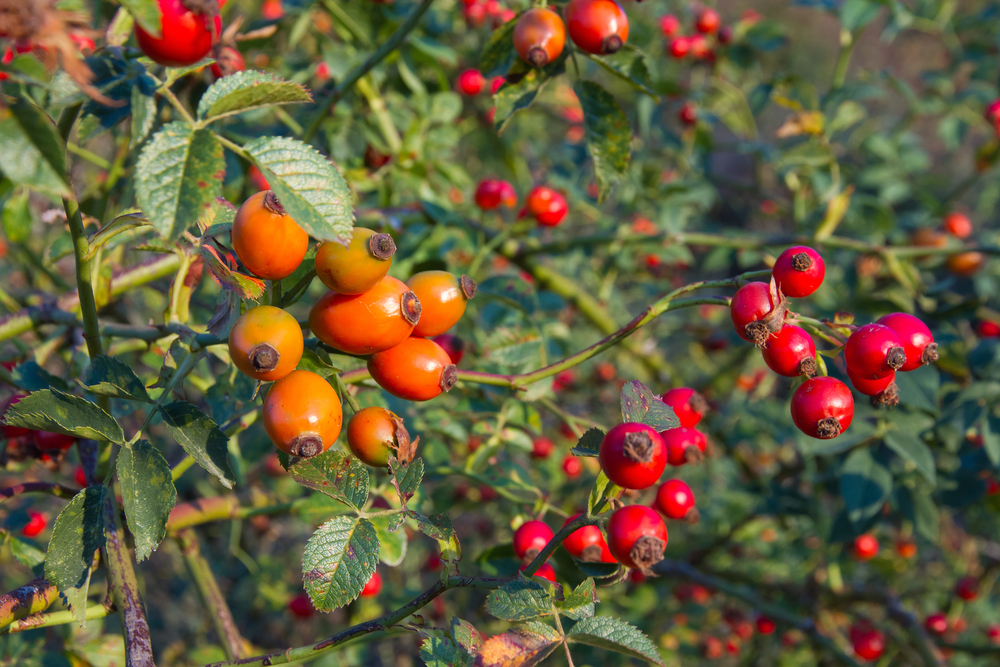
Since roses are an easily recognisable plant for many, especially when they are in flower, identifying sources for rosehip foraging in autumn and winter can begin in summer.
If you see a blooming rose that is not deadheaded too zealously, and which is visited by insects, you could simply mark the location and return to find the hips later in the year.
Hips are a great choice for novice foragers, since they are easy to spot and identify. Of course, for foraging safety, you should always make sure that you are 100% sure of correct identification of anything that you intend to eat.
Look out for the red, crab-apple like hips on the ends of the stems.
Finding Rose Bushes That Bear Rosehips
If you grow roses in your garden, you could have a ready source of rosehips close at hand.
The reason that many gardeners are no longer familiar with rose hips (some do not even realise that roses form these at all) is that we tend to cut back faded rose blooms down to the next stem leaf node in order to encourage more flowers to form.
But leave some faded blooms on your roses and you can see them bearing these red hips.
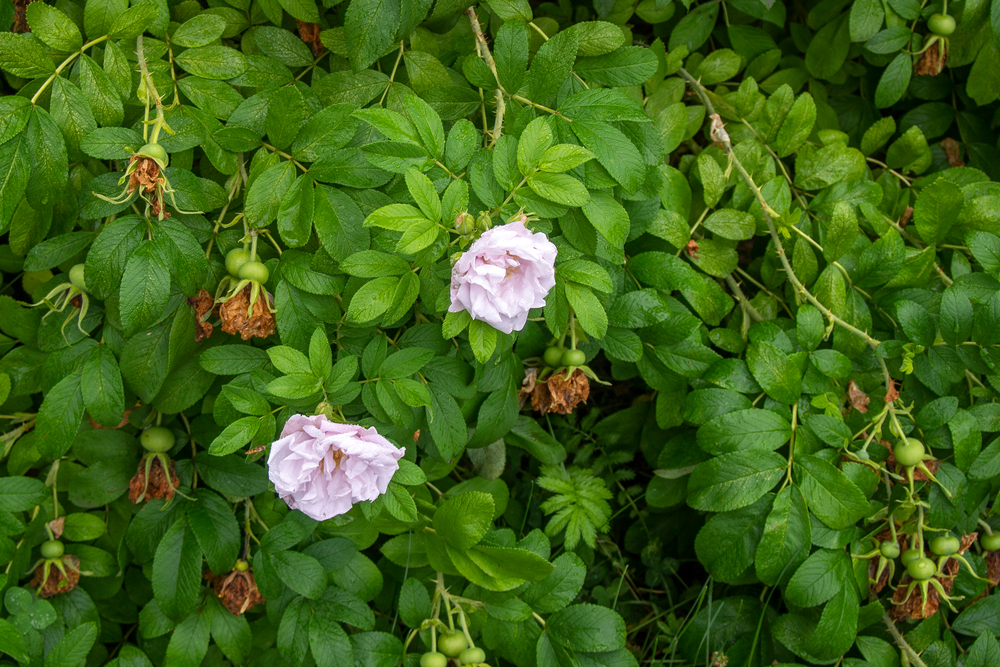
It is a good idea to allow roses to form some hips. Not only can you use hips for your own use, they are also of ornamental value.
Birds and other wildlife love them too, so by leaving some on your plants, you could be doing a favour to creatures who share your garden.

Even if you do not have your own rose bushes, you may still be able to source hips in your neighbourhood, or natural surroundings. You may be able to find them, for example, in a neighbours garden, in local hedgerows, or elsewhere in the wild.
However, when foraging, it is important to always bear two things in mind.
Firstly, always ask permission of the land owner before foraging on private land, and secondly, never forage and consume hips from areas that have been (or may have been) treated with herbicides, pesticides or other harmful chemicals.
When To Forage for & Harvest Rosehips
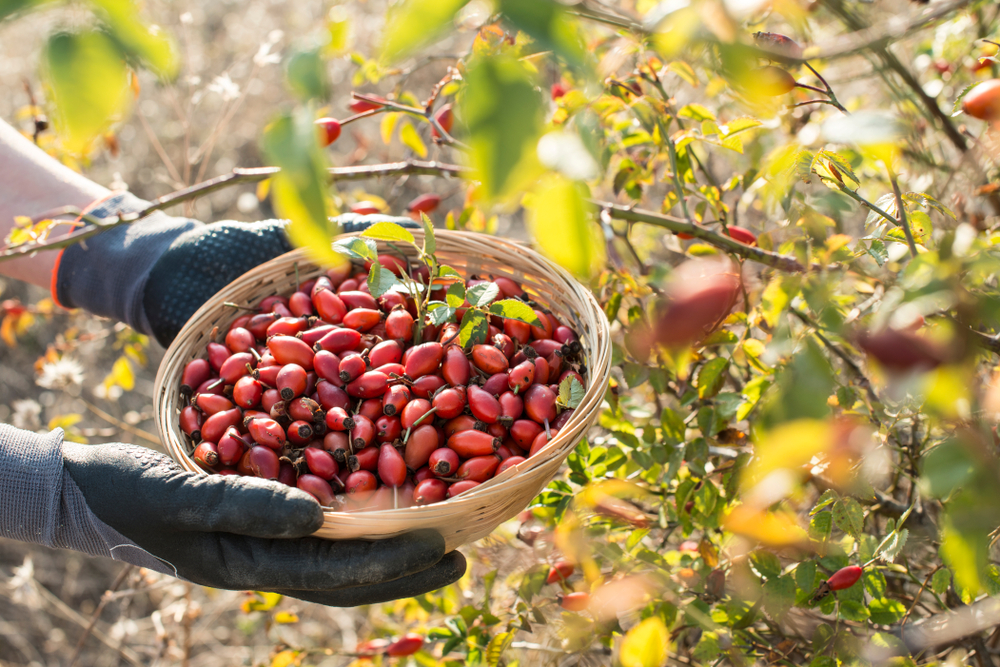
Rosehips will often start to form in early fall. But the best time to look for ripe hips and to harvest them is after the first, light frost.
A light frost will have somewhat sweetened and improved the flavor. However, you should also forage for hips before any hard frosts have frozen the hips solid.
While, especially in areas with somewhat milder winters, hips can be harvested well into the coldest months, it is generally best to harvest earlier rather than later.
Take hips that are full and fleshy, but which can be plucked relatively easily from the canes. These will be ripe, but not too far gone. Avoid picking any hips that are shrivelled or soft and mushy.
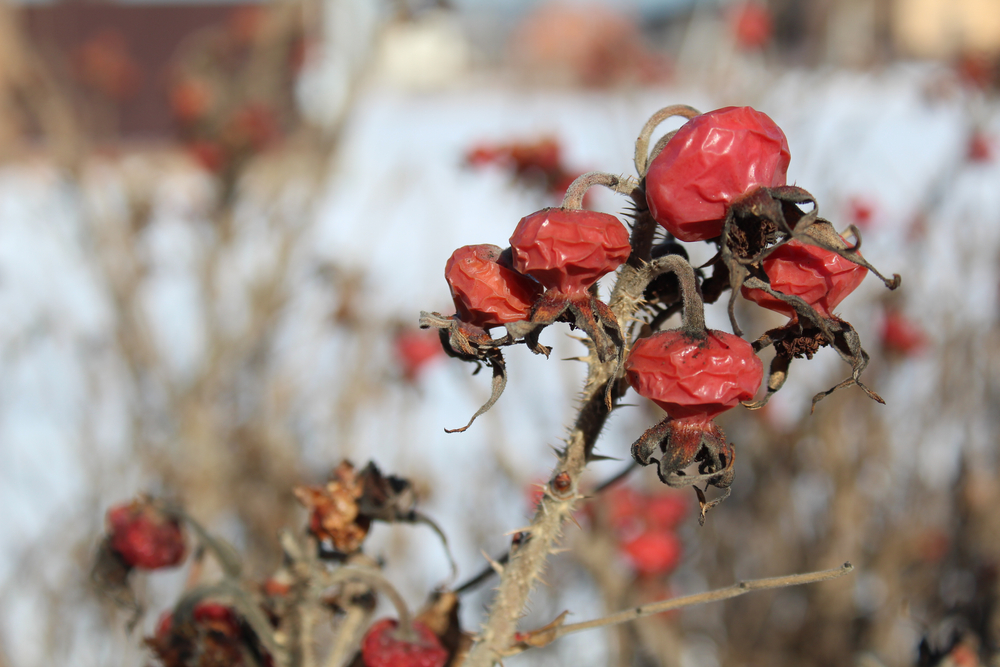
Fully ripe hips can often simply be pulled off the plants, but you can also cut them off using a knife or some secateurs.
Protecting Yourself
Roses are often armed with thorns, and the unwary can easily be scratched. When foraging for rose hips, therefore, it is a good idea to wear long sleeved clothing and a good pair of gloves, and also to keep your legs covered.
Watch out not only for the roses themselves but also other plants in hedgerows or wilder surroundings – such as stinging nettles, bramble briars etc..
You should also protect your hands while processing your hips. Unfortunately, one of the main reasons that rose hips are not more widely used is that the stiff hairs inside can irritate the skin.
In fact, in the past, the insides of rose hips were often used to make itching powder. (Much beloved of mischievous little kids at school, and still sold in some joke shops.)
While the outer flesh of hips can be eaten (raw or cooked), the hairs and seeds must be carefully removed before ingestion. The French name for rose hips, gratte-cul (literally scratch butt) gives a clue as to the results of eating them!
How To Remove Hairs & Seeds
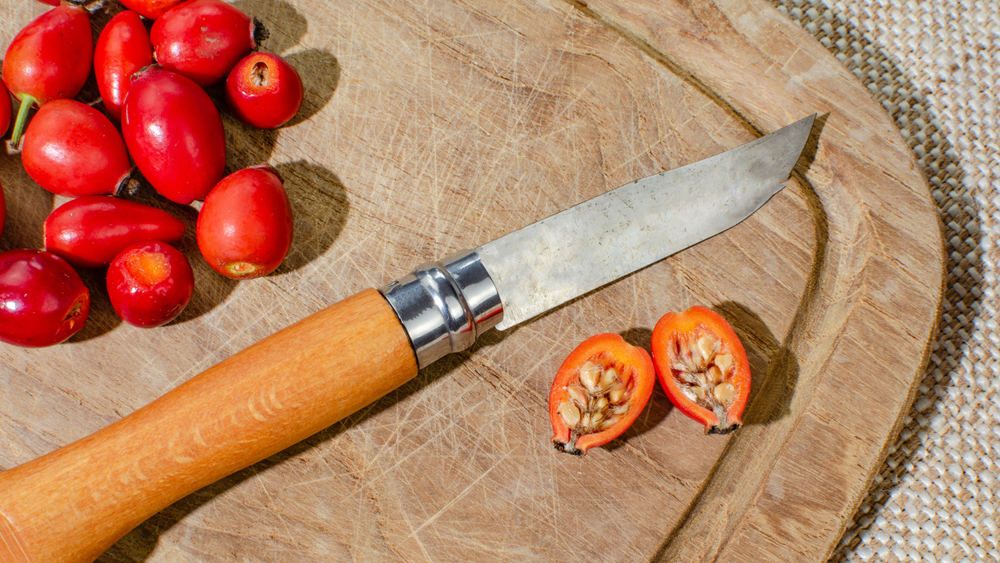
The first stage of processing for many rose hip recipes, therefore, is carefully removing the hairs and seeds from the hips.
First, trim off the stem and blossom ends of the hips and cut them in half lengthways. Very carefully, manually scrape out all the insides.
Next, thoroughly rinse the rose hips by placing them in a colander or other receptacle and pouring water over them until every single hair has been removed.
This will not be necessary for recipes like jellies, where the pulp will be discarded, but will be necessary for many other applications. It can be rather time consuming, but if you are going this route, it is essential to be thorough.
How To Dry Rosehips
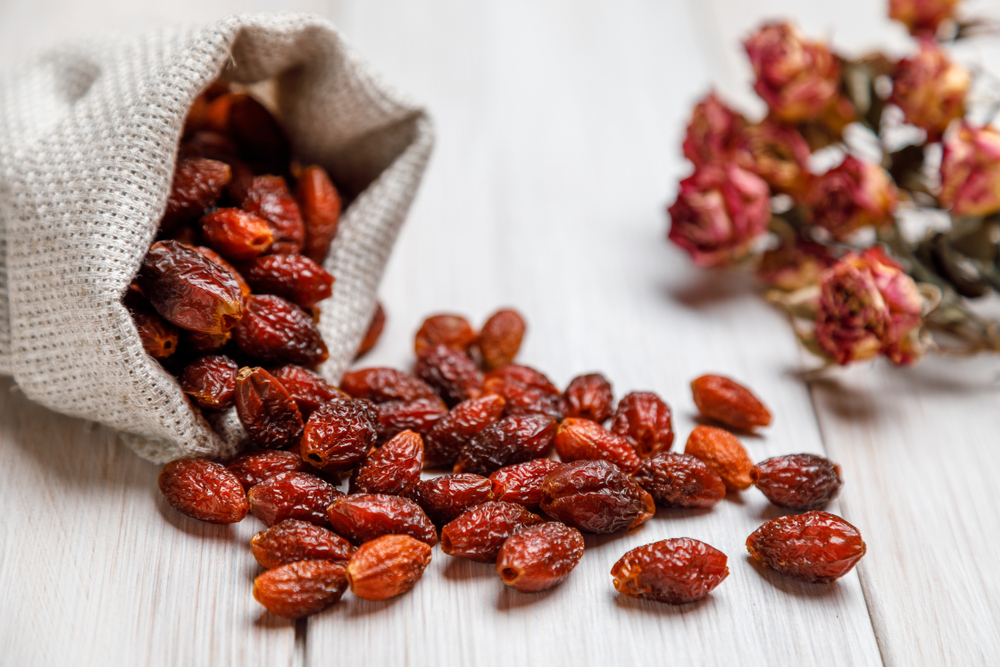
If you do not want to use your rosehips right away, you can dry them. In less humid locations, this can be achieved simply by laying them out on a tray in a sunny windowsill.
However, where humidity is high, drying is best undertaken with a dehydrator, or in an oven.
When the rosehips are dry and brittle, they can be ground into a powder, or stored as they are in airtight jars.
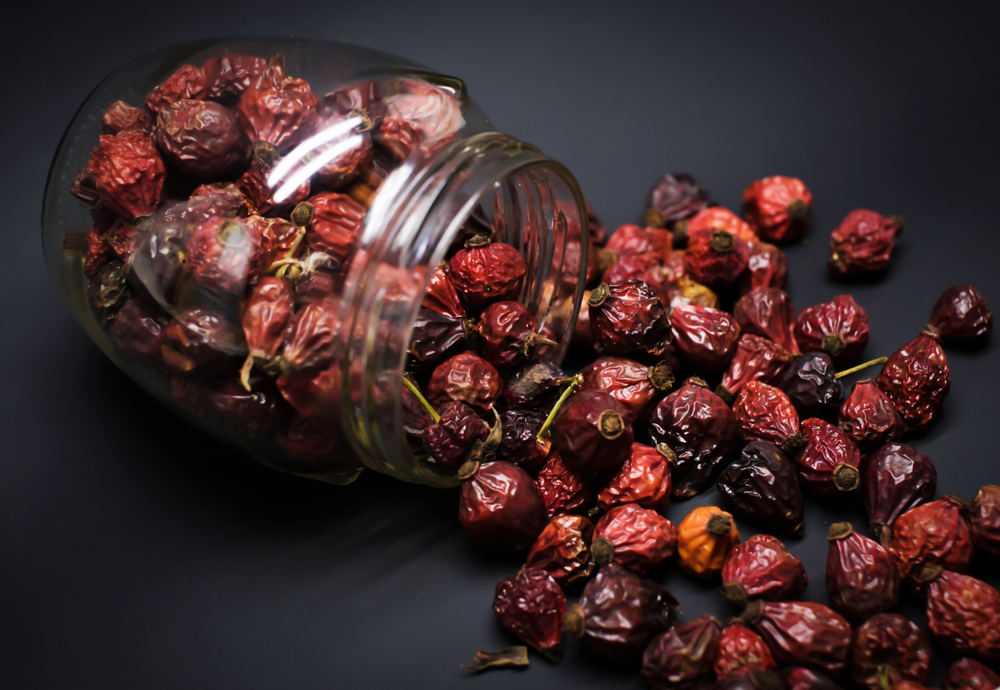
When you wish to use them, you can rehydrate the hips by covering them in water and simmering them on the stove until they are soft.
Then they can be used in much the same way as the fresh hips.
If drying your rosehips seems too time consuming, you can also freeze the halved, cleaned hips for up to a year in your freezer.
25 Ways To Use Rosehips
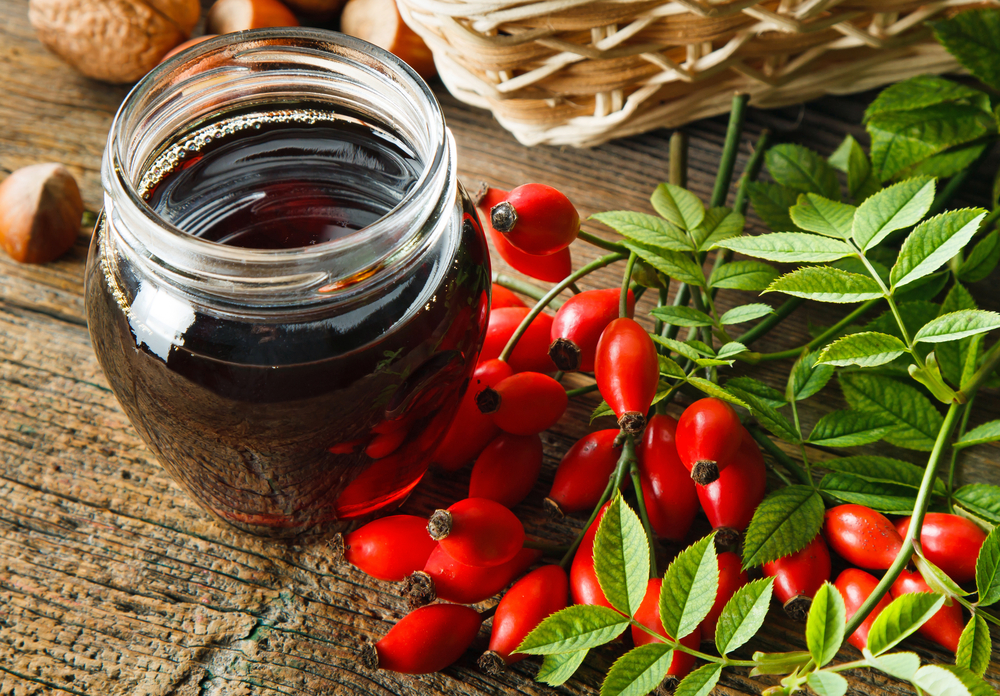
Rosehips are great for a range of culinary uses. As mentioned above, they are rich in vitamin C and other healthful vitamins and can be valuable as an additional food source or natural medicinal additive.
Here are 25 ways to make use of your rose hips:
1. Rose Hip Syrup
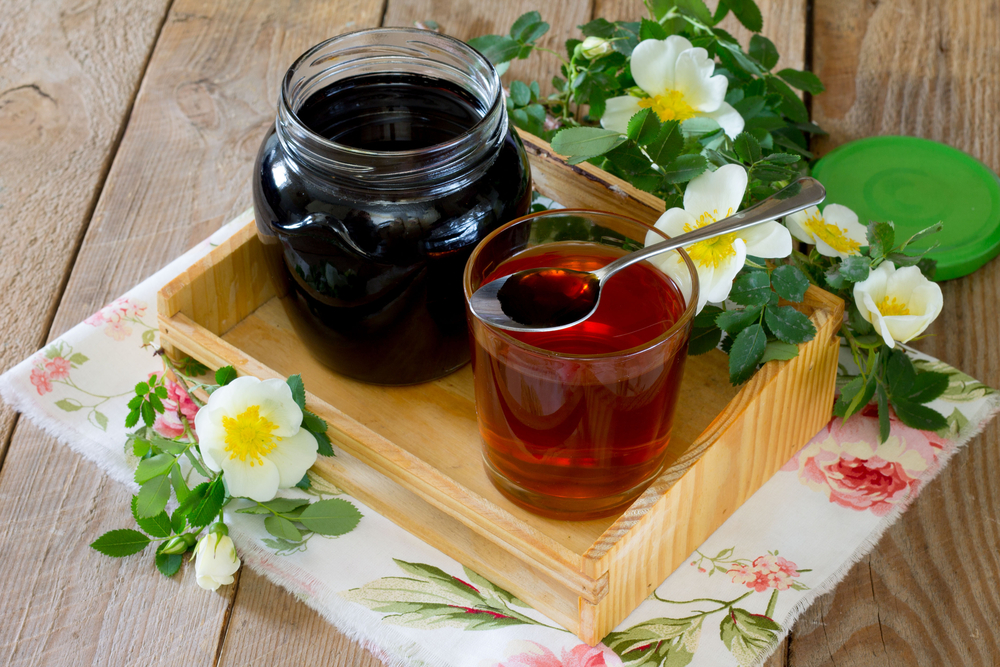
A number of delicious recipes begin with the creation of a syrup. Rosehips are roughly chopped in a food processor then boiled in a large pan of water.
After boiling and simmering, the mixture is strained through a double layer of muslin (to make sure all the irritant hairs are removed) and simmered down with sugar before being bottled.
Rosehip Syrup @ rivercottage.net
2. Rosehip Jelly
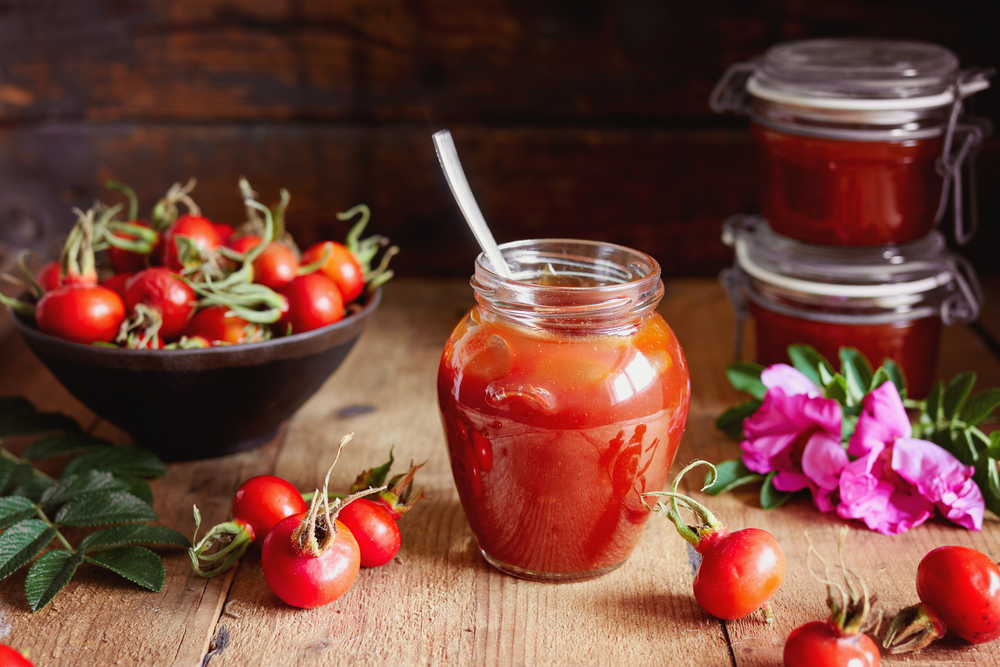
Another very popular way to make use of rosehips is to use them to make a jelly. Often, the rose hips are combined with other fall fruits like apples, or elderberries, for example.
This too involves blending the whole hips in a food processor and boiling them before passing them through a muslin or cheesecloth, allowing the mix to drip through overnight.
The mix is them boiling to setting point then poured into sterilized jars.
Rosehip Jelly @ larderlove.com
3. Rosehip Jam
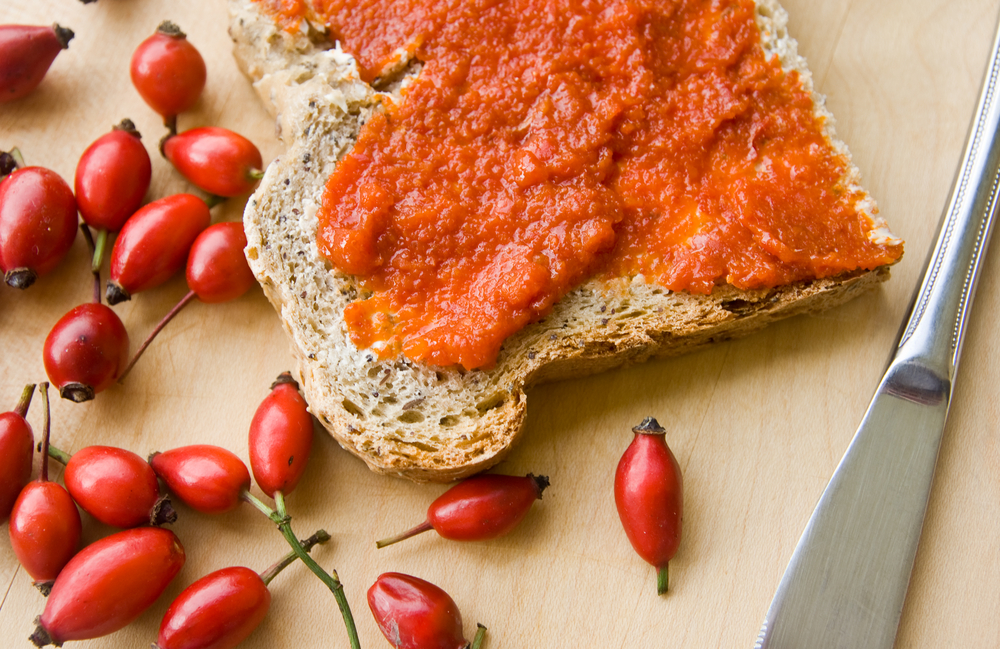
If you do not mind putting in the work, you can also make a jam with the prepared and washed rose hips that you have foraged. Unlike a jelly, this does not involve discarding the pulp.
Again, as with the jelly, jams are often made using a combination of rose hips and other fall fruits. However, you can use rosehips alone as well, as in the recipe below.
Rose Hip Jam@ simplybeyondherbs.com
4. Rosehip Marmalade
You can also use your hips, in a variation on the theme, to make a marmalade style jam, along with citrus fruits and apple.
This delicious recipe requires a bit of work, but will produce fantastic results – a sweet and zesty treat that you can spread on your toast over the winter months for a cold-weather pick-me-up.
Rosehip Marmalade@ greatbritishchefs.com
5. Rosehip Compote
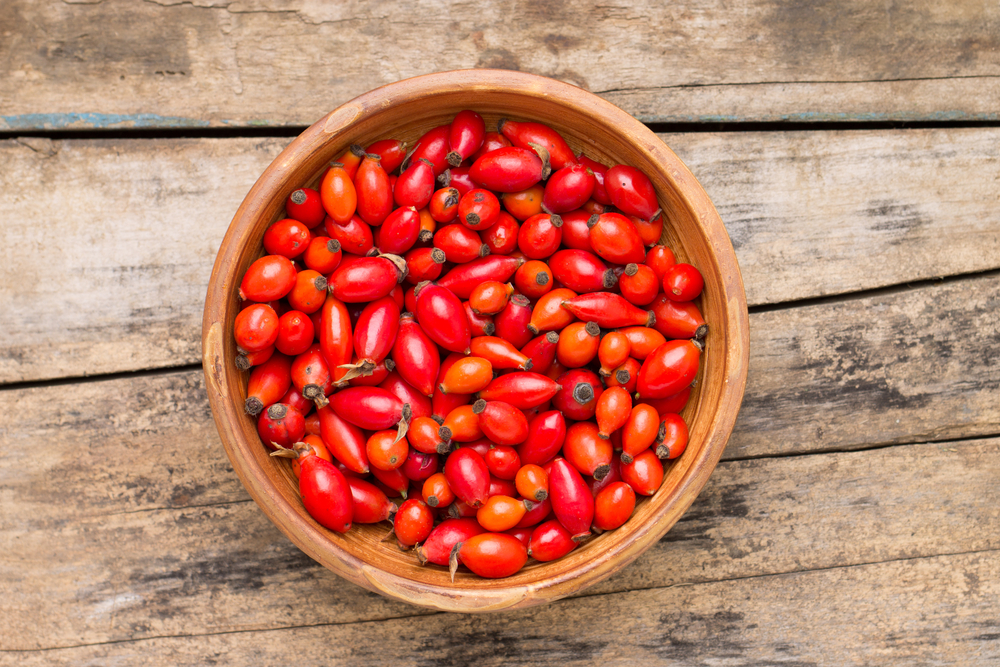
If jellies and jams seem like too much work, (and too much sugar!) you could also consider simply stewing halved and carefully washed rose hips with apple and raisins and other dried fruits to make a delicious and healthy compote.
This stewed fruit mixture can be ideal for breakfast – served atop buckwheat pancakes, perhaps, with a topping of nuts and vegan-friendly fluffy cashew cream.
Rosehip and Apple Compote@ motherearthliving.com
6. Rose Hip Chutney
If you want to preserve your rosehips – but in a rather more savory and less sweet way, then you could consider using some in a chutney.
The chutney recipe below combines rosehips with onion and chillies. But there are also other recipes out there that combine them with tomatoes, or apples, or a range of other ingredients.
Rosehip Chutney @ cooked.com
7. Fruit Leather
Rose hips are one of the hedgerow fruits that can work very well in home-made fruit leathers (fruit roll ups).
The home-made type are so much better than the sickly sweet store bough varieties, and you can make them healthier, if you wish, by using honey or agave syrup rather than sugar. These are great for kids lunches and snacks.
Hedgerow fruit leather @ gallowaywildfoods.com
8. Rose Hip Soup
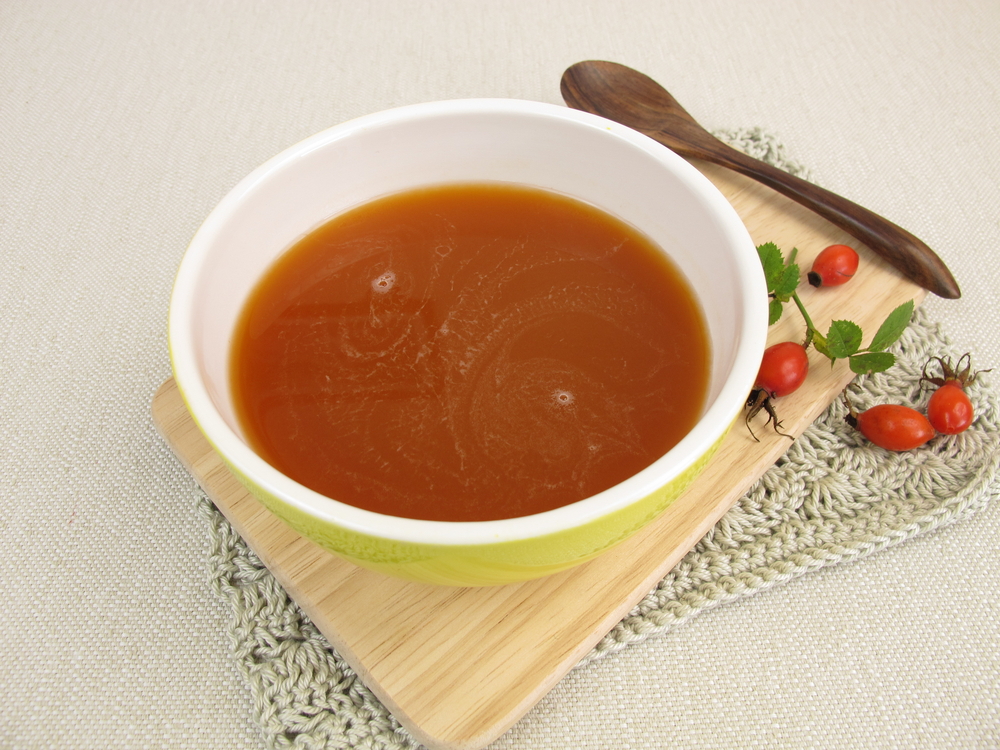
Most of the recipes rosehips are used for are sweet ones. But there is the odd savory suggestion out there. If you want to try something that is a little more unusual, how about making a rosehip soup?
One interesting and different recipe can be found through the link below.
Rosehip Soup @ eatweeds.co.uk
9. Rose Hip Catsup
One old-fashioned but tasty way to use up your hips is in a catsup condiment, that can be used as a more unusual and interesting alternative to tomato based sauces.
There are also several other catsup or ketchup recipes using rosehips in smaller quantities that you could consider.
Rosehip Catsup @ heritagerecipes.com
10. Rose Hip Vinegar
Another condiment you could create very easily and simply with a few of your hips is a fruit infused vinegar.
This could be perfect for zesting up winter salads, or adding some fruity tang to other dishes.
Rosehip Vinegar @ larderlove.com
11. Rose Hip Flour
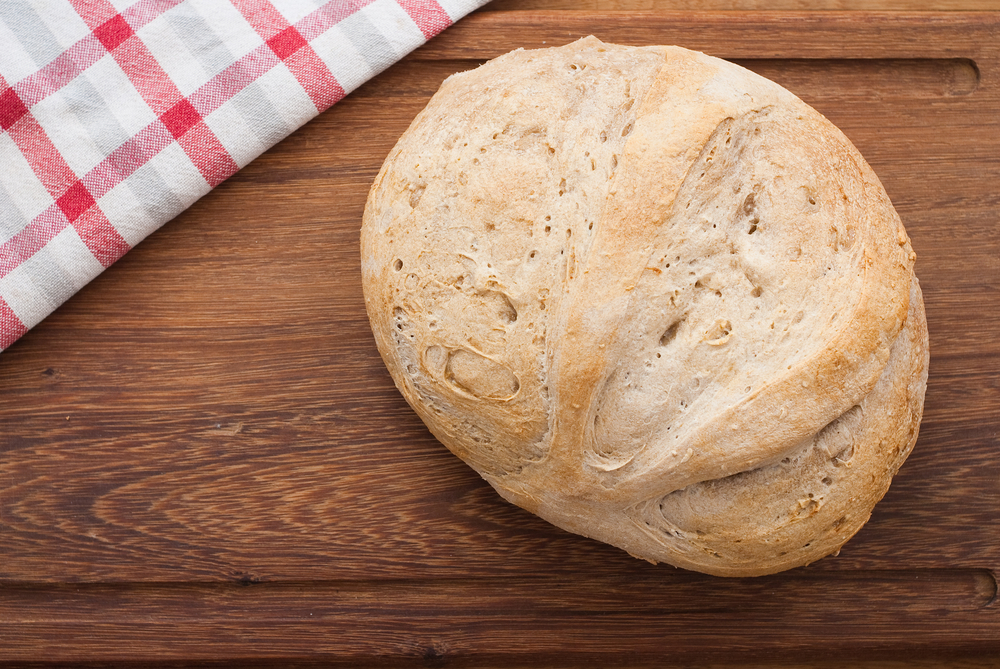
Dried rose hips can be ground into a flour that can be used to enrich a range of breads and baked goods alongside other flours. It has a pleasant, sour aftertaste and of course a range of nutritional goodies.
By making a flour or powder from your dried rosehips you can include their acidic flavour and nutrients in a wider range of recipes.
I like to use rose hip flour/ powdered dried rosehips in home-made breads.
12. Rose Hip Cookies
One other way that you could make use of your dried rosehip flour is to make some delicious cookies.
The recipe below make some simple cookies which incorporate the rose hips to add depth of flavour to the bake.
Rosehip Cookies @ buttersugarflowers.com
13. Rose Hip Tea
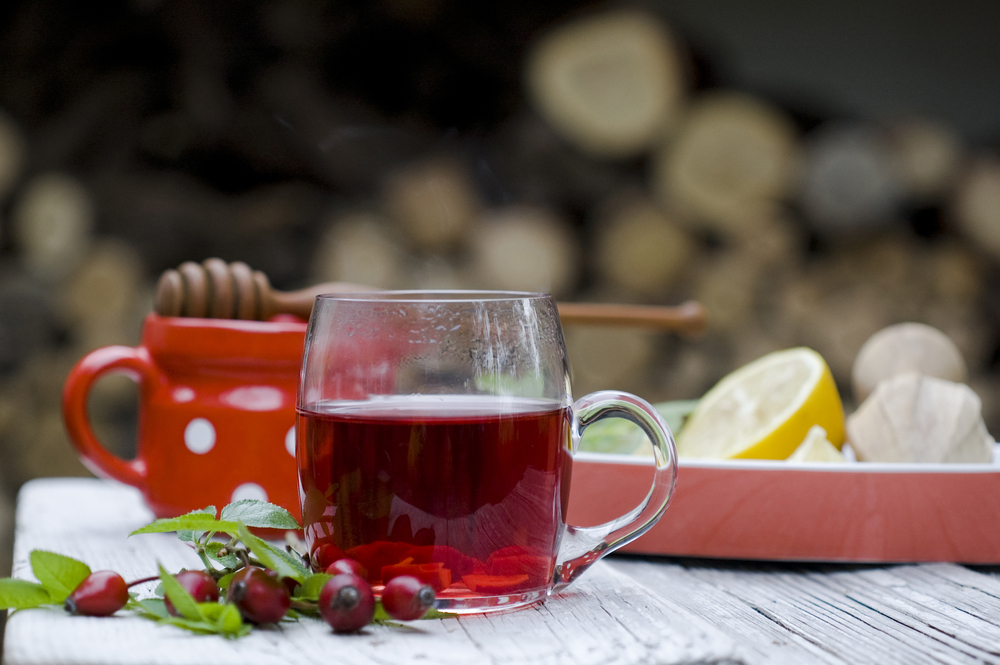
Another common way to use up dried rosehips is in a cup of healthy tea.
This is one of the easiest and simplest recipes for rose hips out there and once the hips are dried, you can use them to make a cup whenever you like.
Rosehip Tea @ earthfoodandfire.com
14. Fermented Rose Hip Soda
Another interesting and relatively easy way to use rosehips (that does not involve fishing out all the seeds and hairs manually) is making a fermented rose hip soda.
The recipe below highlights the ease of this interesting technique.
Fermented rose hip soda@ theprairiehomestead.com
15. Rose Hip Crumble
Crumbles are a warming fall dessert that can really make your family happy.
Stewed rosehips can simply be added to other seasonal fruits like blackberries or apples, for example, and topped with a crumble mix that is to your liking.
You can also bake in a pastry case for a crumble pie variant of this simple recipe.
Rose Hip Crumble Pie @ food.com
16. Mixed Berry Traybake

A mixed berry traybake is a flexible recipe. The recipe below is infused with a rosehip syrup which provides the cake with a tangy finish.
You could adapt this recipe to include a range of cultivated and hedgerow fruits.
Mixed berry traybake @ jordancereals.co.uk
17. Rose Hip Cupcakes
Another recipe which calls for the inclusion of rose hip syrup is this homely and comforting cupcake one which showcases the complex yet pleasing flavour of the hips.
These can allow you to ring the changes and try something slightly different from the usual fall fare without traveling too far out of your comfort zone.
Rose Hip Cupcakes @ cupcakeproject.com
18. Rose Hip Muffins
This is another related but somewhat different, and somewhat healthier recipe which uses rose hips in some apple and raisin muffins.
The hips (free from irritating hairs of course) add pretty speckles to these moist and fruity treats that are fantastic for breakfast.
Rose hip muffins@ motherearthliving.com
19. Rose Hip Mince Pies

Another sweet treat that works well when made with rose hips is mince pies. This is a variation on the Christmas classic that uses rosehips and haws along with the traditional dried fruits in the mincemeat filling.
Since you’ll likely pick the hips in fall, the mince filling will have a chance to mature before you make your pies for the festive season.
Rose Hip Mince Pies @ heathandheather.co.uk
20. Candied Rosehips
Candied hips can be added as an extra ingredient to a range of delicious cakes, or perhaps even used as a cake topping.
Rosehips can be too astringent to add to cake batter as they are, so candying them can be a good choice. Here’s how:
Candied rosehips @ arecipeforgluttony.wordpress.com
21. Rose Hip Candy
You could also consider making a sweet yet tangy treat by making some rose hip candy, as in the recipe at the link below.
Hips (cleaned thoroughly of seeds and hairs) are coated in sugar water, boiled, then rolled in granulated sugar for sweets.
Rose hip candy @ comfreycottages.blogspot.com
22. Rosehip Chocolate Christmas Truffles

Rosehips can be used to add a little something special to your chocolate Christmas truffles. The recipe below calls for the addition of some dried rosehip powder along with the cacao and other delicious ingredients.
Perhaps you could prepare some of these ahead of time and give some away as Christmas presents?
Rosehip chocolate truffles @ greenkitchenstories.com
23. Rosehips Ice Cream
Rose hip syrup can be drizzles over all sorts of dessert dishes. But you could also consider swirling some like raspberry ripple through a home-made ice cream. You can then drizzle more of the syrup over the top too.
Rose hip ice cream@ helengraves.co.uk
24. Sorbet With Rosehips
Another slightly unusual way to use rosehip syrup is to make a rose hip and apple sorbet. This sorbet has a subtle, fruity and floral flavour which can work well as a palate cleanser after a hearty fall or winter meal.
Rosehip and apple sorbet @ rivercottage.net
25. Vitamin-Rich Gummies
One final way that you could consider using your rosehips is to make some healthy vitamin-rich gummies that could help you and your family fend off colds over the winter months.
If you were feeling more decadent, you could also sweeten the mix for lunch box treats, or a pick-me-up on a chilly day.
Rose hip gummies @ medicinalmuskeg.wordpress.com
Rosehips may not be a familiar ingredient to many, but as you can see from the above, they do have a wide range of uses. So this fall, don’t just focus on the blackberries and crabapples – consider foraging for rosehips as well.

Get the famous Rural Sprout newsletter delivered to your inbox.
Join the 50,000+ gardeners who get timely gardening tutorials, tips and tasks delivered direct to their inbox.

